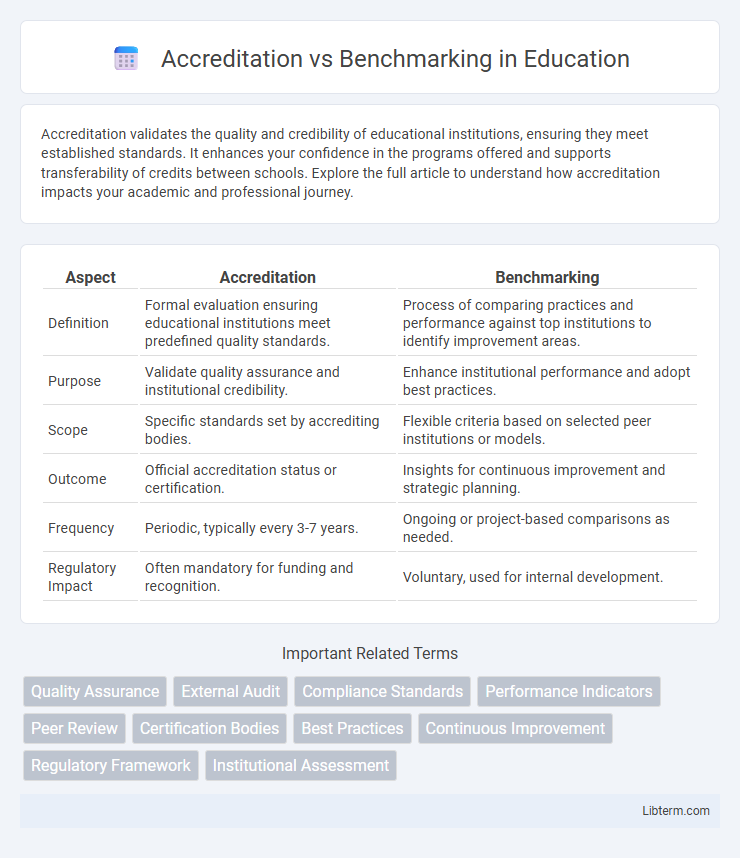Accreditation validates the quality and credibility of educational institutions, ensuring they meet established standards. It enhances your confidence in the programs offered and supports transferability of credits between schools. Explore the full article to understand how accreditation impacts your academic and professional journey.
Table of Comparison
| Aspect | Accreditation | Benchmarking |
|---|---|---|
| Definition | Formal evaluation ensuring educational institutions meet predefined quality standards. | Process of comparing practices and performance against top institutions to identify improvement areas. |
| Purpose | Validate quality assurance and institutional credibility. | Enhance institutional performance and adopt best practices. |
| Scope | Specific standards set by accrediting bodies. | Flexible criteria based on selected peer institutions or models. |
| Outcome | Official accreditation status or certification. | Insights for continuous improvement and strategic planning. |
| Frequency | Periodic, typically every 3-7 years. | Ongoing or project-based comparisons as needed. |
| Regulatory Impact | Often mandatory for funding and recognition. | Voluntary, used for internal development. |
Understanding Accreditation: Definition and Purpose
Accreditation is a formal recognition process in which an authoritative body evaluates an organization, program, or institution against established standards to ensure quality and credibility. Its primary purpose is to validate that the entity meets predefined criteria for performance, safety, and efficacy, fostering trust among stakeholders and enhancing reputation. This systematic assessment supports continuous improvement and accountability within industries such as education, healthcare, and manufacturing.
What is Benchmarking? Key Concepts
Benchmarking is the systematic process of measuring an organization's products, services, or processes against industry bests or best practices from other sectors to identify areas for improvement. Key concepts include competitive benchmarking, internal benchmarking, and functional benchmarking, each focusing on different comparison points to optimize performance and efficiency. This practice emphasizes continuous improvement, data-driven analysis, and adapting proven strategies to drive organizational excellence.
Accreditation vs Benchmarking: Core Differences
Accreditation involves formal recognition by an authoritative body confirming that an organization meets specific standards, while benchmarking compares an organization's processes and performance metrics against industry best practices to identify areas for improvement. Accreditation emphasizes compliance and certification, providing a status symbol that assures quality and credibility, whereas benchmarking focuses on competitive analysis and continuous enhancement through performance measurement. Core differences include the formal assessment and certification aspect of accreditation versus the evaluative and comparative nature of benchmarking.
Benefits of Accreditation in Organizations
Accreditation offers organizations a formal recognition of meeting established quality standards, enhancing credibility and trust with stakeholders. It drives continuous improvement by providing a structured framework for assessing and elevating processes, products, and services. Accredited organizations often experience increased competitive advantage and greater customer confidence, which can lead to expanded market opportunities.
Advantages of Benchmarking for Continuous Improvement
Benchmarking offers a dynamic framework for continuous improvement by enabling organizations to compare their processes and performance against industry leaders, promoting the adoption of best practices. It drives innovation through the identification of performance gaps and the implementation of targeted strategies to enhance efficiency and quality. This ongoing evaluation fosters adaptability and sustained growth, outperforming static accreditation standards by encouraging real-time responsiveness to competitive and operational challenges.
Accreditation Process: Steps and Standards
The accreditation process involves a systematic evaluation based on predefined standards to ensure organizational quality and performance. Key steps include self-assessment, documentation review, on-site evaluation, and continuous improvement aligned with industry-specific criteria set by accrediting bodies. These standards emphasize compliance, accountability, and enhancement of services, distinguishing accreditation as a formal recognition of meeting rigorous quality benchmarks.
Types of Benchmarking Methods Explained
Benchmarking methods include internal, competitive, functional, and generic benchmarking, each targeting different performance comparisons and organizational insights. Internal benchmarking compares processes within the same organization to standardize best practices, while competitive benchmarking evaluates direct competitors to identify industry standards and innovation. Functional benchmarking studies similar functions across industries to adopt best processes, and generic benchmarking focuses on broad business operations, emphasizing continuous improvement regardless of industry specifics.
Challenges in Implementing Accreditation and Benchmarking
Challenges in implementing accreditation include high costs, extensive documentation requirements, and resistance to change from staff, which can delay compliance and impact organizational morale. Benchmarking faces difficulties such as identifying relevant and comparable benchmarks, data accessibility issues, and inconsistencies in measuring performance across different institutions or industries. Both processes demand significant time investment and continuous commitment to improvement, creating barriers for organizations with limited resources or expertise.
Case Studies: Successful Use of Accreditation and Benchmarking
Case studies reveal that accreditation drives healthcare organizations to meet rigorous standards, enhancing patient safety and care quality, as seen in institutions certified by The Joint Commission. Benchmarking enables companies like Toyota to adopt best industry practices, improving operational efficiency and product quality by comparing performance metrics against top competitors. Healthcare and manufacturing sectors both benefit from combining accreditation's compliance emphasis with benchmarking's performance improvement strategies, leading to sustained organizational excellence.
Accreditation or Benchmarking: Which is Right for Your Organization?
Accreditation provides formal recognition that an organization meets established standards, ensuring quality and compliance in regulated industries. Benchmarking involves comparing performance metrics against best-in-class organizations to identify improvement opportunities and drive competitive advantage. Organizations seeking guaranteed adherence to industry standards should prioritize accreditation, while those focused on continuous improvement may find benchmarking more effective.
Accreditation Infographic

 libterm.com
libterm.com